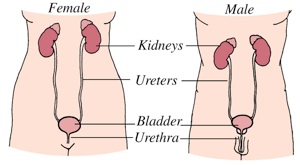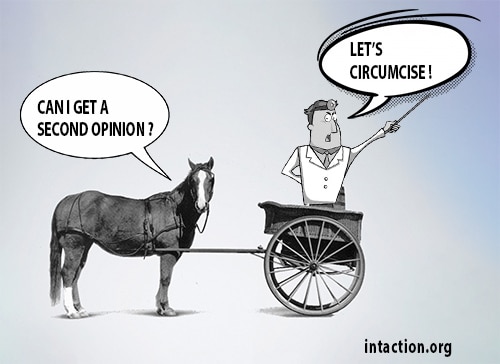
CIRCUMCISED VS UNCIRCUMCISED
What are the TOP 10 questions people want answered?
by Judy Simone
Intaction Research Writer
Updated: Saturday, June 26, 2021
Circumcised vs uncircumcised? This is the question that always comes up when a baby is born. (Please note the proper term for “uncircumcised” is INTACT or NATURAL. The incorrect [uncircumcised] term is printed here only because search algorithms still use it.)
Throughout the ages, circumcision has been surrounded by myths, lies, and hype. Like the claims of health tonic & elixir salesmen of the 19th century, American promoters promise circumcision offers significant advantages while they downplay risks. This article will discuss some of the most frequently asked questions about being circumcised vs uncircumcised.
FAQ 1: Isn’t circumcision is merely cutting off a flap of skin?
ANSWER: When learning about circumcised vs uncircumcised understand this. The foreskin is as much as half of the skin on a penis, not just a flap. In an adult man, the foreskin is 15 square inches of very special skin. The foreskin is the most densely nerve laden part of the penis, containing 240 feet of nerves and 20,000 nerve endings. The foreskin contains dense concentrations of Meissner’s corpuscles, which are special nerve endings especially sensitive to light touch. These highly specialized nerve sensors are one reason why genital cutting is so painful to an infant. The foreskin has unique anatomical features and functions that are the result of millions of years of mammalian evolution.
FAQ #2: Does circumcision hurt the baby?
ANSWER: Circumcision is extremely painful and traumatic for babies, despite claims by some doctors that say babies can’t feel pain. Perhaps the people who say babies don’t feel pain are saying that because they can’t admit the truth to themselves.
In babies and children, the foreskin is adhered to the head of the penis with the same way fingernails are adhered to their nail beds. The first step in circumcision requires shoving a blunt probe under the foreskin to tear the foreskin from the head of the [glans] penis. Then the foreskin is pulled into a special circumcision clamp in order to crush the skin and start the clotting process. It’s the equivalent of placing your finger in a door hinge and slamming the door shut. After the clamp has crushed the skin for 10 minutes the foreskin can be sliced off. You can read more here:
FAQ 3: Do doctors use anesthesia for infant circumcision?
ANSWER: There is no requirement for doctors to use anesthesia (analgesia). Not every doctor uses analgesia. Babies cannot tolerate the type of anesthesia used on adults or older children. The alternatives types of analgesia often used on babies are ineffective.
In 1997, doctors in Canada did a study to see what type of anesthesia was most effective in relieving the pain of circumcision. As with any study, they needed a control group that received no anesthesia. The doctors quickly realized that the babies who were not anesthetized were in so much pain that it would be unethical to continue with the study. Even the best commonly available method of pain relief studied, the dorsal penile nerve block, did not block all the babies’ pain. Some of the babies in the study were in such pain that they began choking and one even had a seizure (Lander 1997). Some babies that don’t scream are actually in shock, and their body doesn’t know how to respond to the overwhelming pain stimulus.
However many doctors are not convinced that babies feel pain. Some think babies are pacified with sugar water during the time when a significant portion of their genitals are sliced off. Most of all, babies can’t complain or file a complaint.
You will never know what happens to your baby in the circumcision room. Some circumcision rooms are sound insulated so parents can’t hear their sons screaming. Most newborns do not receive adequate anesthesia. Babies may go into shock, or may not have the ability to communicate their pain. Nurses often tell parents, “He slept right through it.” They say this so as not to upset them. What parent would want to hear that their newborn son was screaming in agony?
ANALGESIA NOT CONSISTENTLY USED
Only 45% of doctors who do circumcisions use any analgesia at all. Even the dorsal penile nerve block injection leaves the underside of the penis receptive to pain. Obstetricians perform 70% of circumcisions and are least likely to use anesthesia – only 25% do. The most common reasons why they don’t? They don’t think the procedure requires it, and it takes too long (Stang 1998). A circumcision with analgesia takes a half-hour – if they brought your baby back sooner with some Tylenol, he was likely in severe pain during the surgery.

Welcome to the World! Baby experiences the pain of being circumcised
FAQ 4: Can babies remember pain and trauma?
ANSWER: The body is a historical repository and remembers everything. The pain of circumcision causes a rewiring of the baby’s brain so that he is more sensitive to pain later (Taddio 1997, Anand 2000). When debating the merits of circumcised vs uncircumcised you need to understand how this can impact babies. Circumcision trauma impacts the developing areas of the brain known as the hippocampus and amygdala. Circumcision also can cause post-traumatic stress disorder (PTSD), depression, anger, low self-esteem and problems with intimacy (Boyle 2002, Hammond 1999, Goldman 1999). Even with a lack of explicit memory and the inability to protest – does that make it right to inflict pain?
FAQ 5: Does circumcision cause the baby long-term harm?
ANSWER: There are always eye opening realizations when talking about circumcised vs uncircumcised. First, removal of healthy tissue from a non-consenting patient is, in itself, harm (more on this point later). Circumcision has an number of risks and side effects. There is a 1-3% complication rate during the newborn period alone (Schwartz 1990). Subsequent studies have now placed the complication rate at 11.5% Here is a short list what can go wrong.
Common Circumcision Complications
Meatal Stenosis: Many circumcised boys and men suffer from meatal stenosis. Meatal stenosis is scar tissue inside the opening of the urethra (where you urinate.) This is a narrowing of the urethra which can interfere with urination and require surgery to fix. It can originate from a circumcision clamp causing damage to the urethra during circumcision. It can also occur by the opening of a circumcised penis rubbing against diapers or clothing. Removing the scar tissue to correct stenosis is very painful.
Adhesions. Circumcised babies can suffer from adhesions, where the foreskin remnants try to heal to the head of the penis in an area they are not supposed to grow on. Doctors treat these by ripping them open with no anesthesia.
Disfigurement. A significant percentage of infants are permanently disfigured by circumcision malpractice.
Buried penis. Circumcision can lead to trapped or buried penis – too much skin is removed, and so the penis is forced inside the body. This can lead to problems in adulthood when the man does not have enough skin to have a comfortable erection. Some men even have their skin split open when they have an erection. There are even more sexual consequences, which we will address in a future post.
Infection. The circumcision wound can become infected. This is especially dangerous now with the prevalence of hospital-acquired multi-drug resistant bacteria.
Death. Babies can even die of circumcision. Over 100 newborns die each year in the USA, mostly from loss of blood and infection (Van Howe 1997 & 2004, Bollinger 2010).
Psychological Harm
The pain and trauma inflicted on a baby being circumcised can cause life long psychological harm. The “primitive or limbic” brain of an infant is receiving neural stimuli and forming new connections based on them. It’s called “neural firing and wiring.” These areas of the brain are the amygdala and hippocampus, which control memories, emotions, and decision making. Intense pain signals can cause changes in these areas that can affect the person emotionally and behaviorally. Intense pain causes release of cortisol, a fast acting hormone that can hinder brain development.
Babies and PTSD
Babies can suffer from Post Traumatic Stress Disorder (PTSD) due to traumatic pain. This is expressed by episodic crying, physical reactions, startle reaction, or refusal to breastfeed. Circumcision related PTSD may impact a child’s development over time. PTSD from exposure to an early traumatic experience can result in childhood emotional problems, feelings of abandonment, insecurity, and the inability to respond to danger.
FAQ 6: Do you have to get the baby circumcised to keep a baby’s penis clean?
ANSWER: In babies, the foreskin is completely fused to the head of the penis. You cannot and should not retract it to clean it, as this would cause the child pain, and is akin to trying to clean the inside of a baby girl’s vagina. The infant foreskin is perfectly designed to protect the head of the penis and keep feces out. All you have to do is wipe the outside of the penis like a finger. It is harder to keep circumcised baby’s penis clean because you have to carefully clean around the wound, make sure no feces got into the wound, and apply ointment. The foreskin separates and retracts on its own sometime between age 3 and puberty. Before it retracts on its own, you wipe the outside off like a finger. After it retracts on its own, it will get clean during the boy’s shower or bath. There is nothing special that the parents need to do.
FAQ 7: “My uncle/father/friend/cousin wasn’t circumcised and he kept getting infections.” Shouldn’t all men be circumcised to avoid problems?
ANSWER: Studies done in Europe have shown that less than 2% of men there ever need an adult circumcision for a bonafide medical reason. In Europe over 90% of the men are intact.
Bad medical advice can actually cause harm to intact – uncircumcised males. A shocking number of doctors are uneducated about the normal development of the foreskin, and they (incorrectly) tell parents that they have to retract the baby’s foreskin and wash inside it at every diaper change. Doing this tears the foreskin and the tissue (called synechia) that connects it to the head of the penis, leading to scarring and infection.
American doctors receive little medical school education on the care and treatment of the intact penis. The curriculums assume that all men will be circumcised. Doctors in America are trained to circumcise. Hence, when an American doctors encounters an intact penis with a minor problem his first recommendation is circumcision.
Circumcision promoted with misinformation
Misinformation was especially prevalent during the 1950s and 60s, when American infant circumcision rates were he highest. Americans were misinformed about the care of the intact penis. Retracting a child’s foreskin would be like trying to clean the inside of a baby girl’s vagina with Q-tips at every diaper change. Rather than preventing problems, such practices would cause problems by introducing harmful bacteria and tearing delicate tissues. Remember that humans evolved from animals, so no body part that required special care would survive evolutionary pressures. The human genitals require no special care.
In medicine we only treat the sick, injured or diseased. We do not perform surgery for a disease before we have the disease! We do not prescribe antibiotic until there is evidence of infection. We do not perform tonsillectomies until there is repeated tonsillitis. We do not perform mastectomies until there is cancer or a proven high risk of cancer. We don’t put the cart before the horse. So why should circumcision be any different?
FAQ 8: What if my son gets diagnosed with phimosis and has to be circumcised?
ANSWER: When discussing circumcised vs uncircumcised, people wonder about potential problems. Phimosis means that the foreskin will not retract. Since children’s foreskins are naturally not retractable, it is impossible to diagnose phimosis in a child. Foreskin non-retractability may be considered normal for males up to and including early adulthood. Any such diagnoses in infants are based on misinformation. Lack of training in U.S. medical schools on this subject makes doctors very likely to misdiagnosis. Phimosis diagnosis are sometimes made by doctors to obtain insurance coverage for cosmetic/culturally based circumcision for insistent parents. These fraudulent diagnoses are called “phony phimosis.”
Even some adult men have foreskins that do not fully retract, but as long as it doesn’t interfere with sexual intercourse, it is no problem at all, as urination itself cleans the inside of the foreskin (note that urine is sterile when leaving the body.)
In the adult, phimosis can result from a buildup of inflexible scar tissue. This scar tissue can occur from forced retraction and tearing in childhood. Phimosis can also be treated conservatively with a prescription betamethasone steroid cream and gentle stretching done by the man himself, should he so desire it (Ashfield, 2003). This will help to breakdown the scar tissue and restore the skin’s elasticity. This process can take several months, along with some diligence and patience. There are devices available online to also assist with treating phimosis. These treatment decisions can and should be made by the adult man.
FAQ 9: Don’t uncircumcised boys get more urinary tract infections (UTIs)?
ANSWER: This issue is always raised when having the circumcised vs uncircumcised debate. Now realize the following. Girls have a 3 times higher rate of UTI than boys. Yet no one suggests cutting girls genitals to prevent UTI. When a girl gets a UTI, she is 
NO LINKS BETWEEN FORESKIN AND UTI’S
There have been many studies since which show either no decrease in UTI with circumcision, or else an increase in UTI from circumcision. Thus circumcision is not recommended to prevent UTI (Thompson 1990).
FAQ 10: Doesn’t circumcision prevents HIV/AIDS?
ANSWER: Three studies in Africa several years ago claimed that circumcision prevented HIV transmission and that circumcision was as effective as a 60% effective vaccine (Auvert 2005, 2006). These studies had many flaws, including expectation bias (both researcher and participant), selection bias, lead-time bias, attrition bias, duration bias, and early termination that favored the treatment effect the investigators were hoping for. (Van Howe, Storms 2011: How the circumcision solution in Africa will increase HIV infections.) It as been suggested that the researchers tailored the studies to reach the conclusions they wanted. Read more about how circumcision is a dangerous mistake for HIV prevention.
There have also been several studies that show that circumcision does not prevent HIV (Connolly 2008). There are many issues at play in the spread of STDs which make it very hard to generalize results from one population to another.
WHAT THEY DON’T SAY ABOUT CIRCUMCISION
The issue of being circumcised vs uncircumcised is a worldwide concern. In Africa, where the recent studies have been done, most HIV transmission is through male-female sex, but in the USA, it is mainly transmitted through blood exposure (like needle sharing) and male-male sex. Male circumcision does not protect women from acquiring HIV, nor does it protect men who have sex with men (Wawer 2009, Jameson 2009).
What’s worse, because of the publicity surrounding the African studies, men in Africa are now starting to believe that if they are circumcised, they do not need to wear condoms, which will increase the spread of HIV (Westercamp 2010). Even in the study with the most favorable effects of circumcision, the protective effect was only 60% – men would still have to wear condoms to protect themselves and their partners from HIV.
In the USA, during the AIDS epidemic of the 1980s and 90s, about 85% of adult men were circumcised (much higher rates of circumcision than in Africa), and yet HIV still spread.
It is important to understand, too, that the men in the African studies were adults and they volunteered for circumcision. Babies undergoing circumcision were not given the choice to decide for themselves.
FAQ 11: Doesn’t a son need to look like his dad?
ANSWER: The major difference that boys notice is that dad’s penis has hair, and is larger. When a boy notices the difference between his foreskin and his father’s lack of one, just tell him, “When your father was born, they thought that you had to cut off the foreskin, but now we know better.” Since when does parent/child bonding require a matching set of genitals? Also, at some point in time someone’s father in the family tree had to be intact. Where was the concern for matching genitals then?
Adding fuel to the fire in the circumcised vs uncircumcised debate, can be a father protecting is own body image. If it is okay for his son to stay intact, then the father must consider that he did not have to be circumcised. Therefore the father must admit that he is missing an important part of his penis. However it is unethical to physically alter a child’s body for a father’s emotional benefit.
FAQ 12: Because my first son was circumcised don’t I have to circumcise my second son?
ANSWER: You can explain this to your children the same way as with the circumcised father. There are plenty of families who changed their minds after one or more sons were circumcised, and didn’t circumcise any more. Children can be told that at one time, parents though circumcision was necessary. However as new medical information became available, it was decided that circumcision was no longer necessary.
FAQ 13: My husband is the one with the penis, shouldn’t he make the decision?
ANSWER: If your husband is circumcised, he has no idea what having a foreskin is like, and he is likely operating from a psychological position of needing to believe that what was done to him was beneficial and important. This further complicates decisions about which is better, circumcised vs uncircumcised. The baby is the one who is going to have to live with the decision for the rest of his life, not your husband. Mothers have the important role of protecting their children. The baby will be the one who has to use the penis for urination and sex — it should be his decision.
Mothers have a duty to protect their children. Relinquishing this decision to the “man” is patriarchal behavior.
FAQ 14: Isn’t everyone is circumcised?
ANSWER: World-wide, only 20%-30% of men are circumcised, and most of these men are Muslim (WHO 2007). Most modern, Westernized countries have rates well below 20%. In the United States about 25 years ago, around 85% of babies were circumcised. The rates have dropped below 55% in 2009, according to a report by the Centers for Disease Control National Hospital Discharge Survey. It is now assumed that the majority of baby boys in America are being left intact.
FAQ 15: Won’t other boys will tease or bully an intact (uncircumcised) boy?
ANSWER: What other cosmetic surgeries will we perform on our children to prevent them from being teased? Should a “flat” girl get implants? What about the boy with a small penis? What surgery would be recommended for him? Circumcised babies are the minority now, and so intact will not be mocked. Plus, as our husbands say, “You just don’t look at or comment on another man’s penis in the locker room.”
FAQ 16: Doesn’t circumcision makes sex better for the woman?
ANSWER: The function of the foreskin for women in intercourse is to seal the natural lubrication inside the vagina and provide a gentle internal massaging action. The intact penis moves in and out of its foreskin, which provides a frictionless, rolling, gliding sensation. Intact men tend to make shorter strokes that keep their bodies in contact with the clitoris more, thus aiding female orgasm (O’Hara 1999). On the other hand, the circumcised penis functions like a piston during intercourse – the head of the penis actually scrapes the lubrication out of the vagina with each stroke. As the man thrusts, his skin rubs against the vaginal entrance, causing discomfort, and sometimes pain (O’Hara 1999, Bensley 2001). Far from making sex better for women, circumcision decreases female satisfaction.
FAQ 17: Don’t women avoid sex with uncircumcised men?
ANSWER: In a landmark study of US women, 85% who had experienced both circumcised and intact men preferred sex with intact men. Sex with a circumcised man was associated with pain, dryness and difficulty reaching orgasm (O’Hara 1999). In another study, women were twice as likely to reach orgasm with an intact man (Bensley 2003). Even when a woman said she preferred a circumcised partner, she had less dryness and discomfort with intact men (O’Hara 1999).
FAQ 18: Have you ever heard that being circumcised affected one’s sex life?
ANSWER: Men who are circumcised are 60% more likely to have difficulty identifying and expressing their feelings, which can cause marital difficulties (Bollinger 2010). Circumcised men are 4.5 times more likely to be diagnosed with erectile dysfunction, use drugs like Viagra, and to suffer from premature ejaculation (Bollinger 2010, Tang 2011). Men who were circumcised as adults experienced decreased sensation and decreased quality of erection, and both they and their partners experienced generally less satisfaction with sex (Kim 2007, Solinis 2007). The foreskin contains several special structures that increase sexual pleasure, including the frenulum and ridged band (the end of the foreskin where it becomes internal), both of which are removed in circumcision. The LEAST sensitive parts of the foreskin are more sensitive than the MOST sensitive parts of the circumcised penis (Sorrells 2007).
A SENSITIVE ISSUE
In other words, if you wanted to decrease a penis’ sensitivity the most, circumcision would be the ideal surgery. The foreskin has nerves called fine-touch receptors which are clustered in the ridged band (Cold 1999). This type of nerve is also found in the lips and fingertips.
To get an idea of the sensation these nerves provide, try this experiment: first lightly stroke your fingertip over the back of the other hand. Now stroke your fingertip over the palm of your hand. Feel the difference? That is the kind of sensation the foreskin provides, and the circumcised man is missing. It may feel like the penis is overly sensitive to a circumcised man because there is little sensation left to indicate excitement, leading to unexpected premature ejaculation (a common problem with circumcised young men). However, as circumcised penises age they become calloused and much less sensitive. See these pictures of circumcised vs intact penises – courtesy of Dr. Momma.org – Warning contains graphic content.
FAQ 19: Do doctors and hospitals have a profit motive to push circumcisions?
FACT: Circumcision is a billion dollar business. Doctors and hospitals have certain revenue expectations they need to meet. For instance they hire billing consultants whose job it is to make sure staff charges insurance companies the maximum amount. They also make sure patients are asked (sometimes repeatedly) for permission to do additional money making procedures. Mothers are not allowed to leave the maternity ward with a son unless she is asked about doing a circumcision first. They are counting on mothers, often still under the effects of painkillers, to say yes. Doctors and nurses may act disappointed or even become hostile to parents if they refuse to sign the circumcision consent form.
As insurance companies and Medicaid cut back reimbursements, doctors are under more pressure than ever to push more billable procedures. As they say, doctors talk “billable.”
Well that ended up being a lot more than 10 myths, but there are so many myths surrounding circumcision we felt compelled to be as complete as possible.
Article originally published on Feb 20, 2013





I have been a member of and ambassador for Intact America for several years. As an intact male, I am fully repulsed by circumcision. It is a violation, cruel mutilation of the penis. The ONLY time circumcision should occur is when the owner of the penis gives consent. The U.S. obsession to circumcise is a serious mental dysfunction, propelled by self-interest money making groups who lie to parents about the “benefits” of circumcision. There are NONE. The AAP and the AMA should be challenged at every opportunity to NOT support or condone circumcision. The moral obligation is to protect the person and their appendage; that penis belongs to them, no matter their age. An wholesale effort/crusade must be engaged to stop this inhumane act.
Thank you for your comments. We need more Americans like you !
I truly appreciate your response! Circumcision is an unnatural act against the body, the unkindest cut a male will experience. The penis is scarred for life, thereafter. How anyone would consider this “normal” escapes my comprehension at any level.
So very grateful to my parents for leaving me intact. Dad told me about proper cleaning very early and I’ve never had any problems.
And they say it’s genetic, but I have reason to believe that being “cut” may stunt the growth in the penis area.
Never had a female partner complain, in fact the opposite if she had never experienced it before me.
Well my step mom fucked me over fml